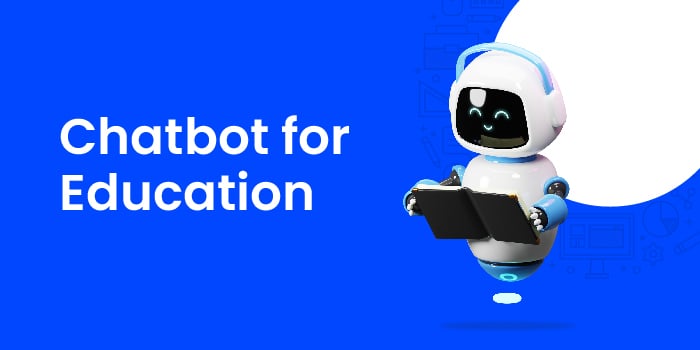Every enrolment season, universities face the same race: win the attention of prospective students before someone else does. The institutions pulling ahead aren’t the ones relying on long email chains and delayed responses – they’re the ones meeting students in the moment. By using AI lead scoring to instantly identify high-potential prospects, and a chatbot for education to provide 24/7 personalized support, these universities are turning casual inquiries into committed applicants at record speed.
Let’s explore how institutions can use chatbots for students to boost enrolments, automate routine administrative tasks, and deliver personalized interactions throughout the student journey.
5 Key use cases for education chatbots
An AI chatbot in education can reduce your staff’s workload, give students faster responses, and highlight areas where human intervention isn’t necessary.
Common queries, such as those related to financial aid, course information, and instructor details often have straightforward answers that a chatbot can handle instantly, or the student can be guided to the right resource page.
Let’s look at a few practical examples and use cases of educational chatbots:
1. Education chatbots to disseminate information
Query | How can chatbots help? | Sample question |
Course details and applications | Provide information about the available courses and answer any queries related to admissions. | What are the pre-requisites to enrol for an MBA course? |
Fees, financial aid, and payment links | Share the entire fee structure, important deadlines for payment, scholarships, and more. | How can I apply for a full scholarship? |
Campus stories | To attract the right talent and improve enrolments, colleges need to share their brand stories. Chatbots can share this information when the student enquires about the college. | What kind of student clubs do you have? Can you share some information about campus life? |
Virtual campus tours and school events | Before the student decides to apply for a course, parents and the student would like to know more about the campus facilities as well as the kind of exposure their child can get. Chatbots can automatically address these concerns. | I would like to take a campus tour. |
Information on course instructors | It is important for the student to know their instructors or the realities of how easy or difficult a course is. You can set up sessions with current faculty or student ambassadors to answer any queries of this nature. Chatbots can share their credentials, set up quick chat sessions, etc. | Who teaches the basics of marketing? Can I talk to someone who has taken this course recently? |
2. Chatbots to improve admissions rates
Education chatbots aid the admissions process in many ways —decreased student drop-offs, shorter response times, automated follow-up reminders, and faster query resolution.
You can combine the power of chatbots with a higher education CRM (Customer Relationship Management) that can set up robust automations to nudge a student to complete their applications.
Here’s how it works:
- Lead generation: LeadSquared’s chatbot can engage with potential students, answer their queries, and collect relevant information during conversations. This data can then be seamlessly captured within LeadSquared, where it is stored as student leads.
- Lead nurturing: LeadSquared’s automation features enable personalized and timely communication with the collected leads. Using pre-defined workflows, send targeted reminders, notifications, and follow-up messages to nudge students towards completing their college application.
- Application reminders: The education chatbot integrated can be programmed to send automated reminders to students who have started an application but have not yet completed it. These reminders can be triggered based on specific criteria, such as time elapsed or specific stages within the application process.
- Personalized assistance & guidance: LeadSquared’s conversational AI capabilities enable the chatbot to provide personalized guidance to students. It can address individual concerns, offer support, and provide relevant information needed to complete the application successfully.
- 24/7 information desk: Students rarely have questions neatly within business hours. AI assistants answer FAQs, direct students to relevant resources, and gently prompt them to complete key onboarding steps, all without the wait time.
- Understanding unspoken needs: By closely interpreting student responses (even what’s unsaid), these smart assistants can detect hesitations or knowledge gaps—making it easier to offer encouragement, suggest support services, or personalize learning materials for better retention and academic success.
3. Interactive learning chatbots
It’s not easy for an instructor to resolve all doubts during lectures, and setting additional time afterward can get overwhelming. That’s where learning bots step in.
These bots engage students in real-time conversations to support their learning process. They can simulate a classroom experience, deliver personalized learning content, and adapt to individual student needs. Interactive learning chatbots can offer quizzes, exercises, and educational games, providing an engaging learning environment.
4. Assessment and evaluation chatbots
There’s one thing that professors find more time consuming than prepping for the next class—grading tests. The purpose of these assessments is to understand how well the students have grasped a particular topic. But chatbots like Quizbot can take that pain away.
Quizbot, an AI-Powered chatbot, can administer quizzes and evaluate student performances. Quizzes can be automatically created, deliver real-time feedback for wrong answers, adapt to various difficulty levels, and add a touch of gamification for improved student engagement.
These chatbots contribute to a more efficient and effective assessment process while promoting active student engagement and facilitating personalized learning journeys.
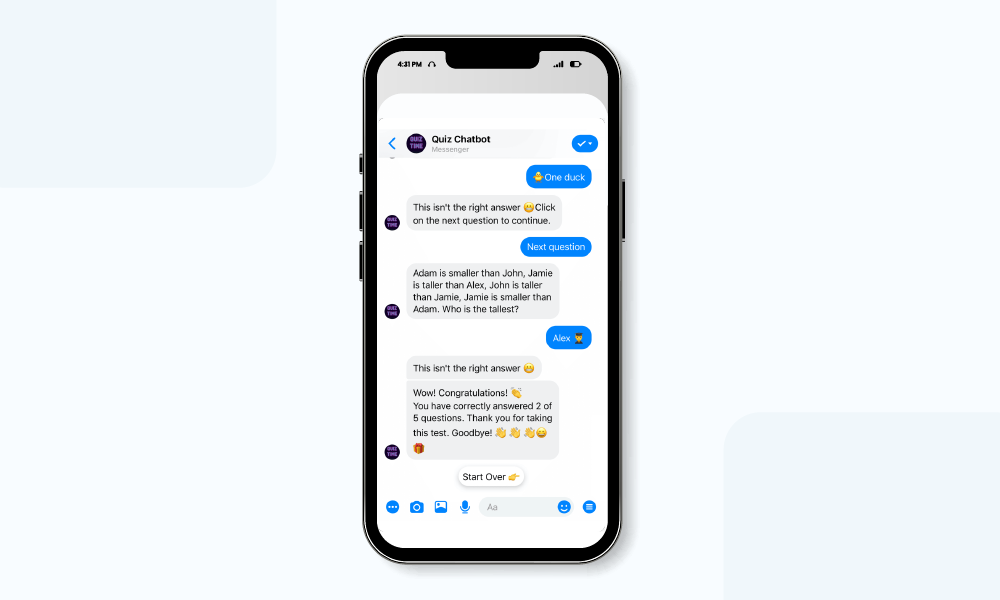
Benefits of education chatbot + CRM duo for your admissions teams
The most obvious benefit of using a chatbot for your admissions is all the time your admissions team will save. But let’s see how it can improve processes and metrics to help you get more student enrollments.
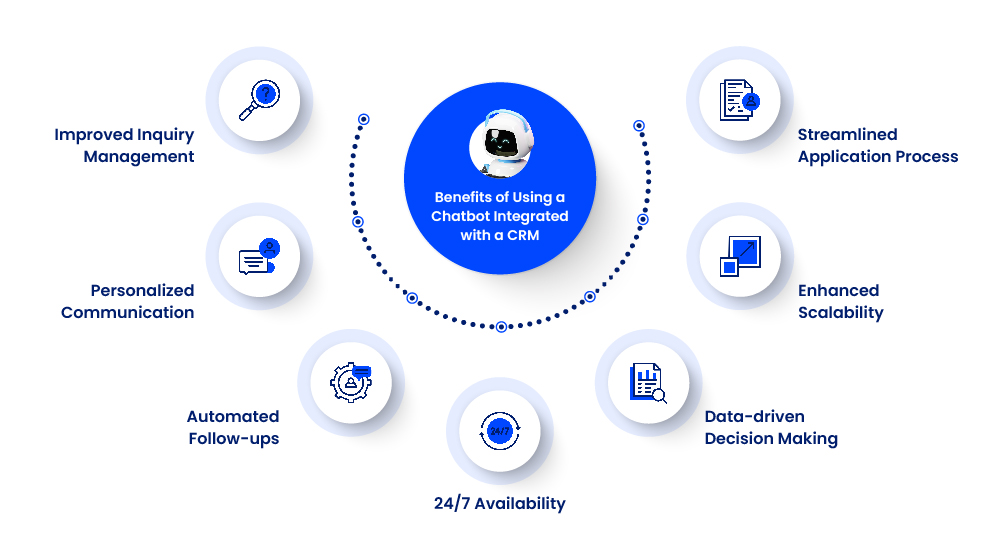
1. Streamlined data
The chatbot can assist students in filling out application forms, provide guidance on required documents, and offer reminders about deadlines. The relevant data captured by the chatbot can be seamlessly transferred to your CRM, allowing the admissions team to manage and organize leads in a centralized system. This streamlines the student management process and ensures that no potential students slip through the cracks.
A higher-education CRM like LeadSquared can integrate with different chatbots, capture that information, and give your counselling teams a one-shot view of the student’s journey so far.
2. Automated follow-ups
An integrated chatbot and CRM, enables automated follow-ups for incoming enquiries. The CRM can trigger personalized messages, reminders, and notifications to prospective students at various stages of the admissions process. This automated follow-up reduces manual efforts, and increases the chances of conversion.
3. Data-driven decision making
Effective student journey mapping with the help of a CRM offers robust analytics and insights. By integrating the chatbot’s data into the CRM, the admissions team can gain valuable insights into student’s behavior, engagement levels, and conversion rates. The team can then take data-driven decisions by identifying trends, optimizing recruitment strategies, and allocating resources effectively.
4. Enhanced scalability
As the number of prospective students and enquiries increases, manually managing and responding to each one becomes challenging. An AI-powered chatbot can handle a high volume of enquiries simultaneously and cater to a larger pool of students without compromising the quality of engagement.
So, does this mean that only the admissions team and teachers can take advantage of a chatbot? Nope. Here are some of the other teams that can also take advantage of a chatbot for their processes.
Departmental versatility beyond admissions
The benefits of education bots extend well beyond admissions:
- Student Support Services: Resources that are easily accessible and prompt responses to frequently requested queries
- Career Services: Help with networking, interviewing, and job searches.
- Library Services: Libraries provide services like catalog lookups, citation assistance, and overdue notices.
- IT Support: Quick assistance with password resets, troubleshooting, and program access.
6 Effective education chatbot templates
Here is a list of your holy grail templates to get started with while implementing a chatbot for your admissions workflow:
1. Admission enquiry
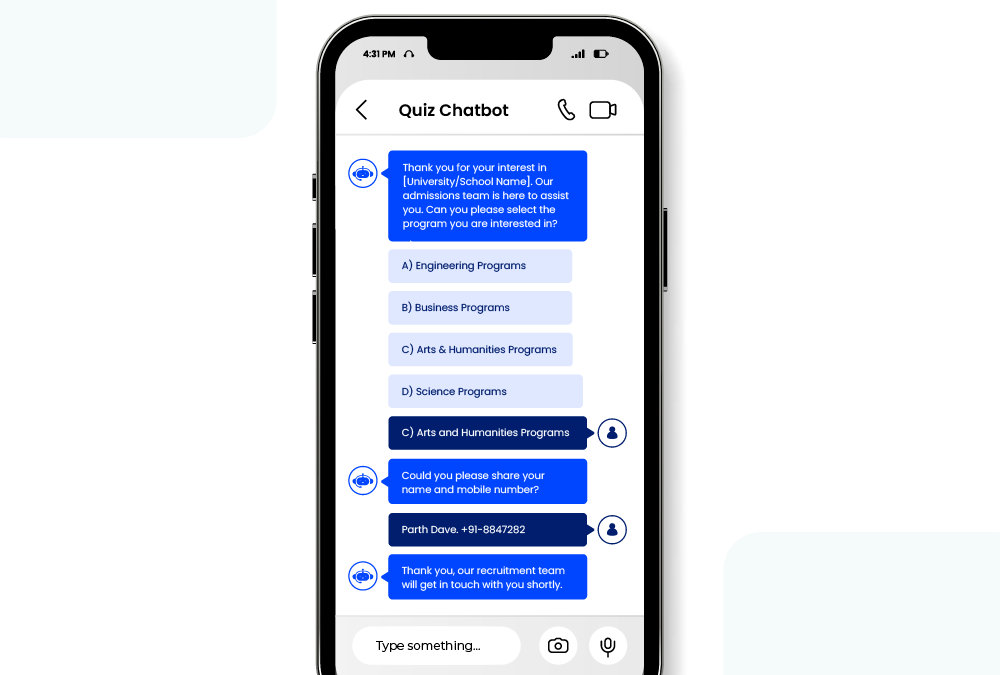
2. Course details
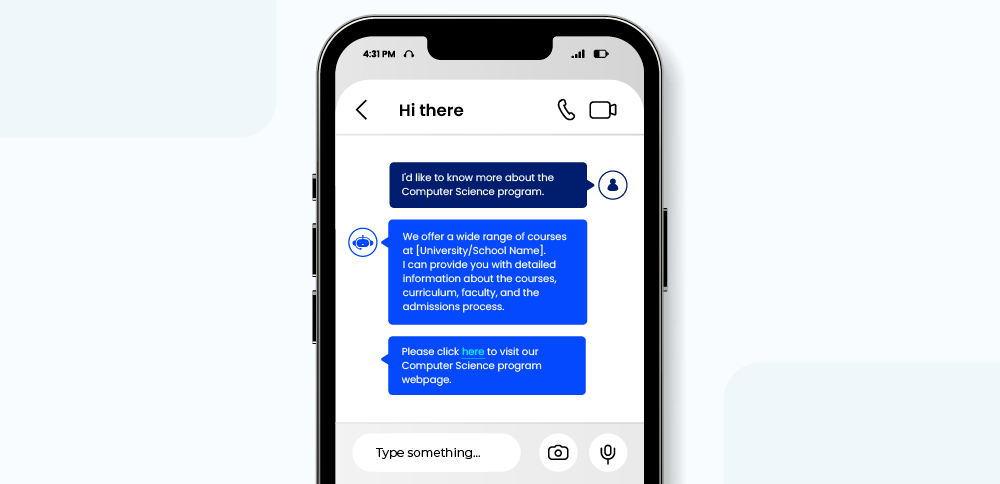
3. Financial aid details
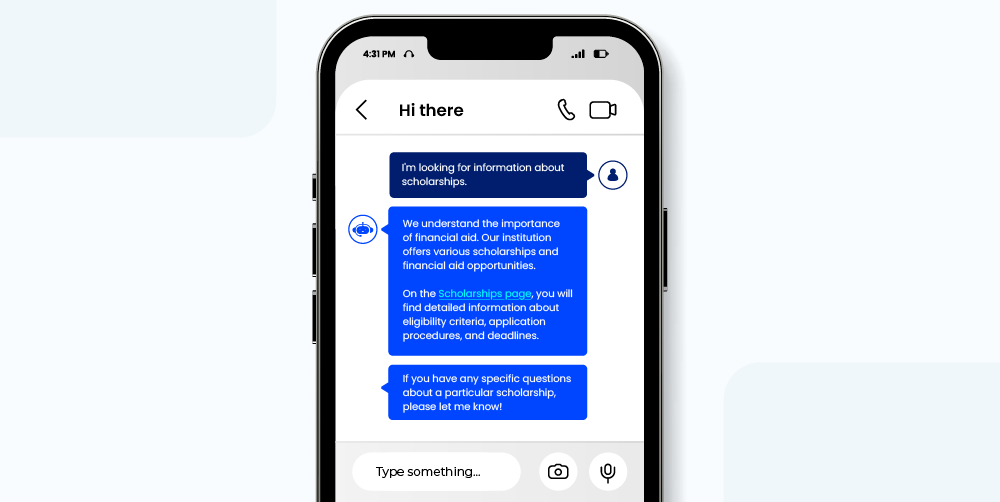
4. Reminders to complete the application
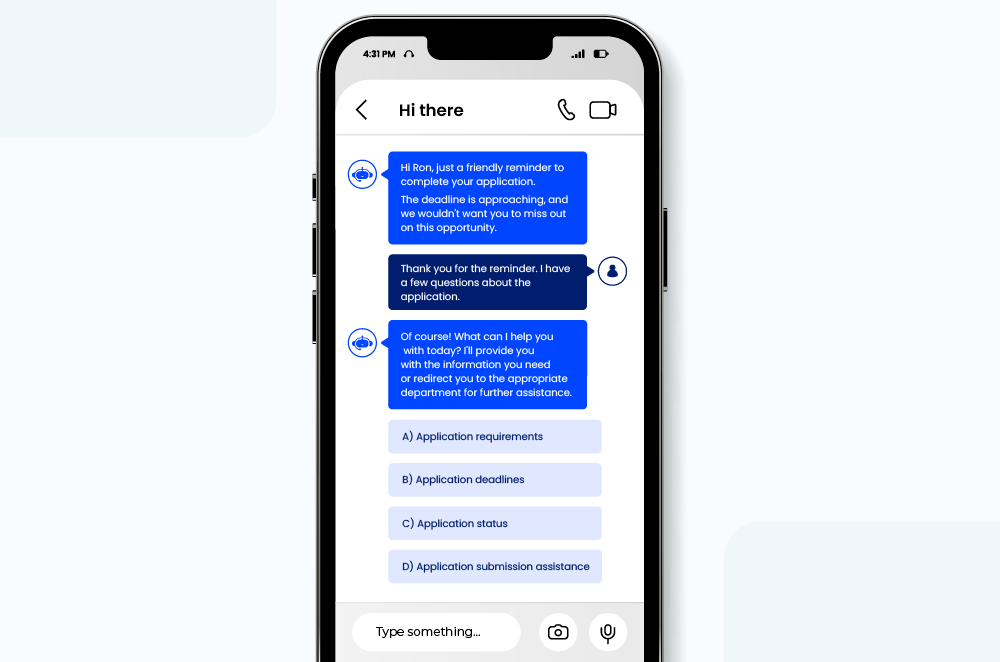
5. Fee payments
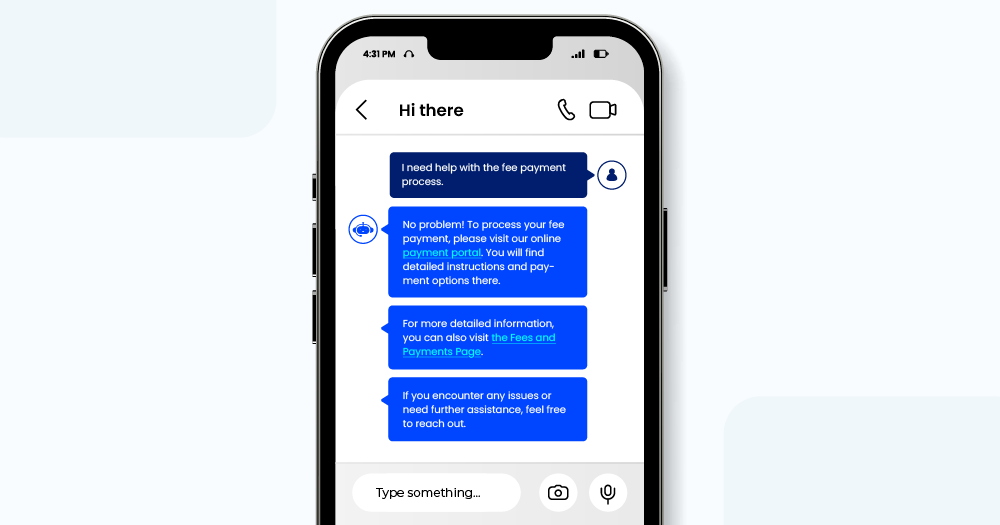
6. Virtual campus tour appointment
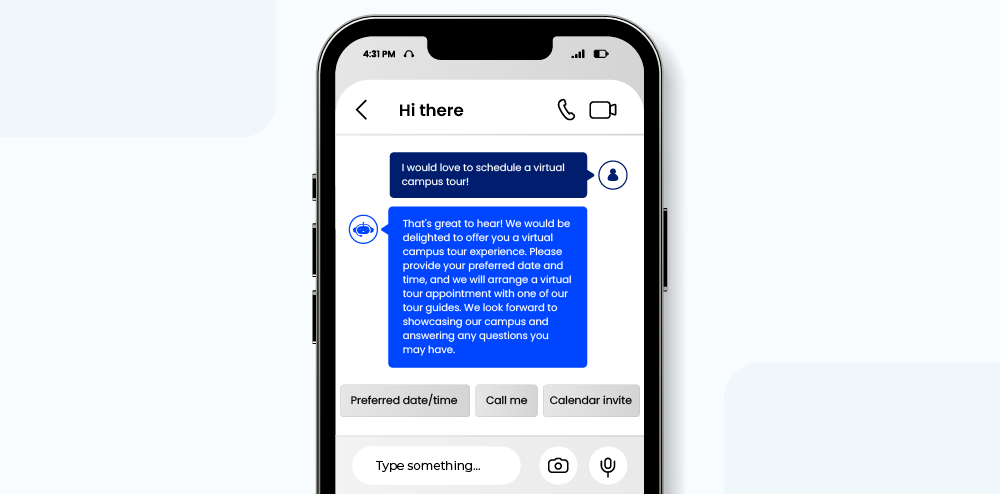
How to set up an AI chatbot for your institution
Now that you have your templates handy, are you ready to bring a chatbot to life at your college or university? Good news: implementing an education chatbot doesn’t require a computer science degree. Here’s a straightforward way to get your virtual assistant up and running in three steps.
1. Map out the chatbot journey
Start by outlining what you want your chatbot to do. Think about common questions from students, parents, and staff—admissions enquiries, course information, or IT support. Plan each step your chatbot will walk users through, like welcoming them, collecting details, or sharing campus highlights. Platforms like LeadSquared, Haptik or Intercom make this as easy as drag-and-drop.
2. Add conversations and Q&A
Feed your chatbot the right questions and answers. Anticipate queries like “What’s the application deadline?” or “How do I reset my password?”. Many platforms let you upload FAQs or use AI to suggest common questions. Keep your Q&A updated so your chatbot stays sharp.
3. Launch and integrate
Publish your chatbot on your website or integrate it with WhatsApp, Facebook Messenger, or Microsoft Teams. Tools like LeadSquared, Drift, or HubSpot offer API integrations to connect with student portals or learning management systems for a seamless experience.
With your chatbot live, collect feedback and iterate—treat it like any campus resource, always improving the student and staff experience.
Now, let’s set up a chatbot for your higher education institution.
Top 6 chatbots for education
Here’s a list of chatbots you can choose from:
1. LeadSquared Chatbot for Education
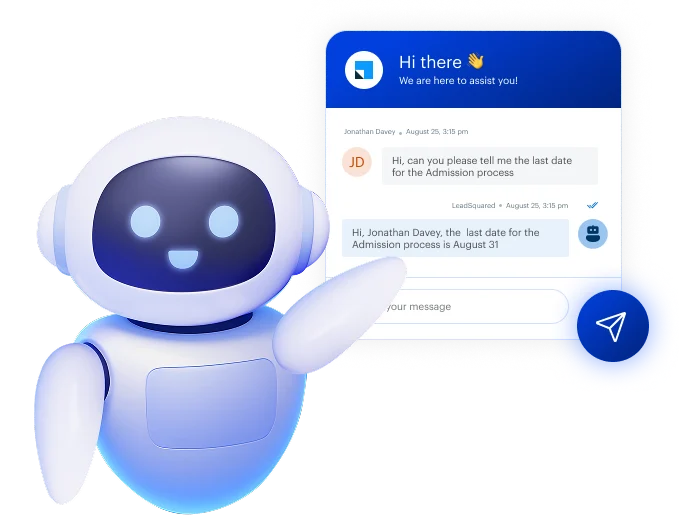
LeadSquared offers AI-powered chatbot solutions specifically designed for educational institutions to streamline student engagement, automate admissions processes, and provide 24/7 support for enquiries.
Key Feature: Provides intelligent lead qualification and automated follow-ups with built-in CRM integration, allowing educational institutions to capture, nurture, and convert prospective students effectively while tracking their entire journey.
Pro: Native integration with LeadSquared’s education CRM ensures seamless data flow from initial enquiry to enrolment, with automated lead scoring and personalized nurturing campaigns.
Con: May require initial setup time to configure optimal conversation flows for your specific institution’s needs.
2. Haptik
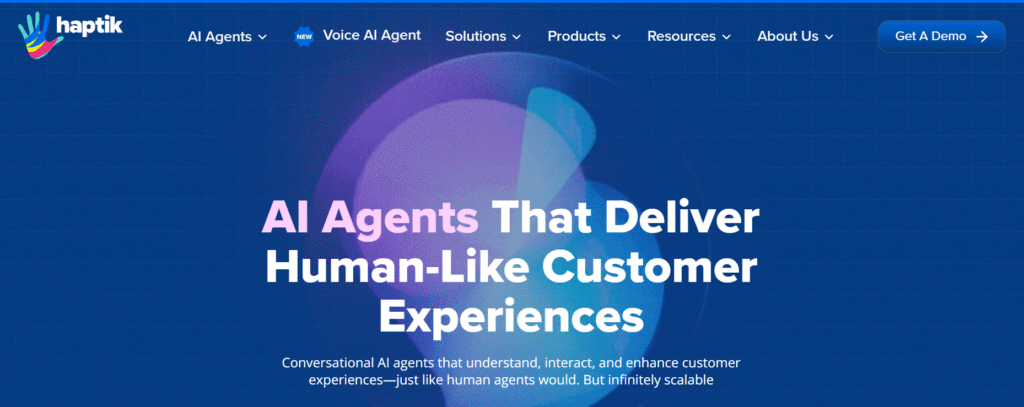
Haptik offers customized solutions for educational institutions to provide personalized assistance to students, handle admissions enquiries, guide them through the application process, and more.
Key Feature: Offers a highly customizable chatbot platform with advanced natural language processing (NLPs) capabilities, allowing educational institutions to create personalized and interactive experiences for students.
Pro: It integrates seamlessly with various channels such as the LeadSquared CRM, websites, mobile apps, and messaging platforms, ensuring a consistent and accessible user experience.
Con: Occasional delays in response time during peak usage periods.
3. IBM Watson Assistant
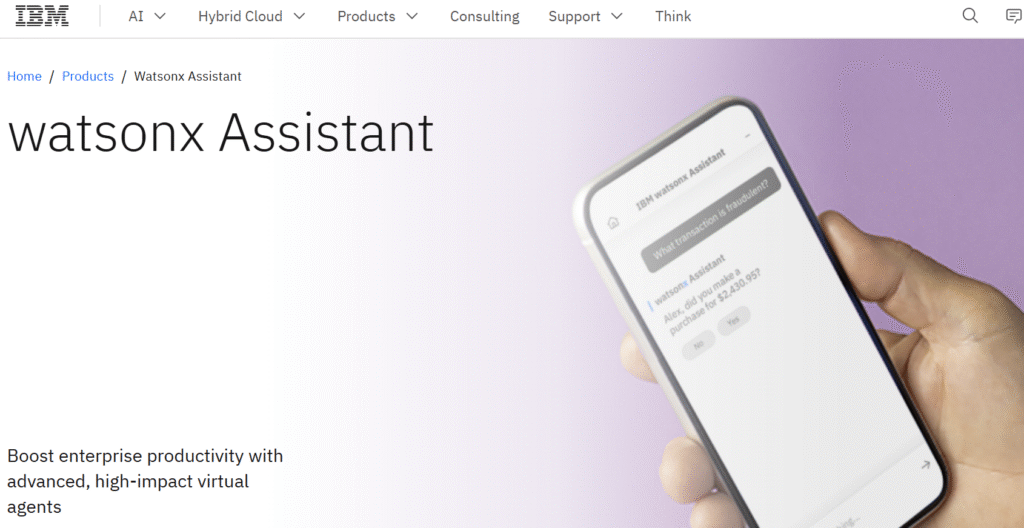
IBM Watson Assistant helps answer student queries, provides course information, assists with research, and offers personalized recommendations for academic resources.
Key Feature: Leverages advanced AI capabilities and responds to queries with close to 100% accuracy. It also maintains every chatbot instance on a single interface.
Pro: The platform’s ability to integrate with other IBM services and solutions allows for seamless data sharing and collaboration if the institution is using IBM services in their existing infrastructure.
Con: Initial setup and training process for the chatbot can be time-consuming and require technical expertise.
4. Ada Support
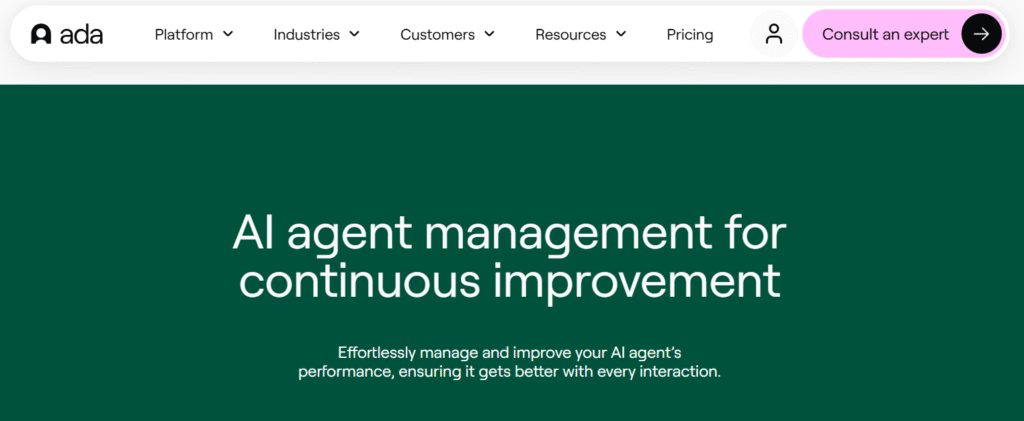
Ada Support offers automated support to students, answers frequently asked questions, assists with enrolment, and provides real-time guidance on various academic matters.
Key Feature: Excels in its ability to provide personalized and context-aware responses to student enquiries through its AI-powered chatbot.
Pro: Has a user-friendly interface and ease of customization, allowing institutions to tailor the chatbot to their specific needs and branding.
Con: Challenges in fine-tuning the chatbot’s responses to ensure accuracy for niche or specialized queries.
5. Ivy.ai
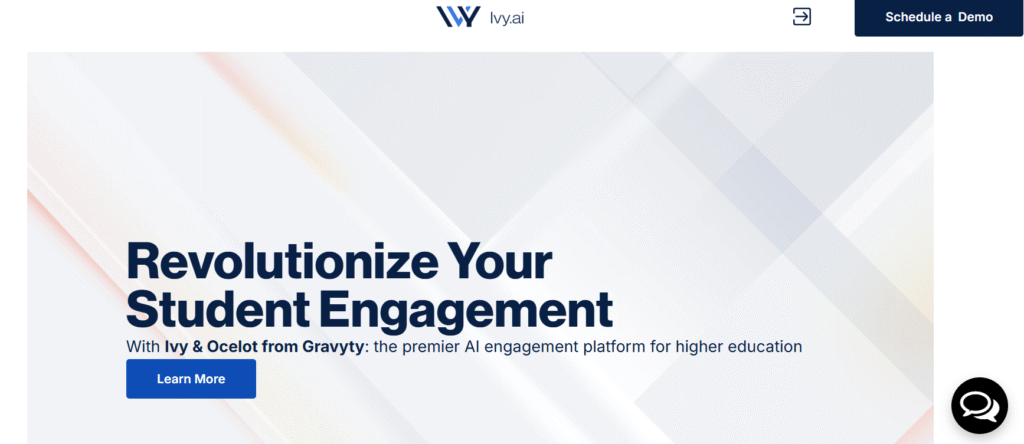
Ivy.ai is specifically developed for higher education. It supports students by providing information on admissions, course details, financial aid, campus services, and academic resources. It can handle complex student enquiries.
Key Feature: Provides a personalized and conversational experience for students, offering AI-powered support throughout the student lifecycle, from admissions to graduation.
Pro: Helps capture and get insights into the specialized needs of the students.
Con: The implementation process and initial training of the chatbot can require dedicated resources and expertise.
6. Botpress
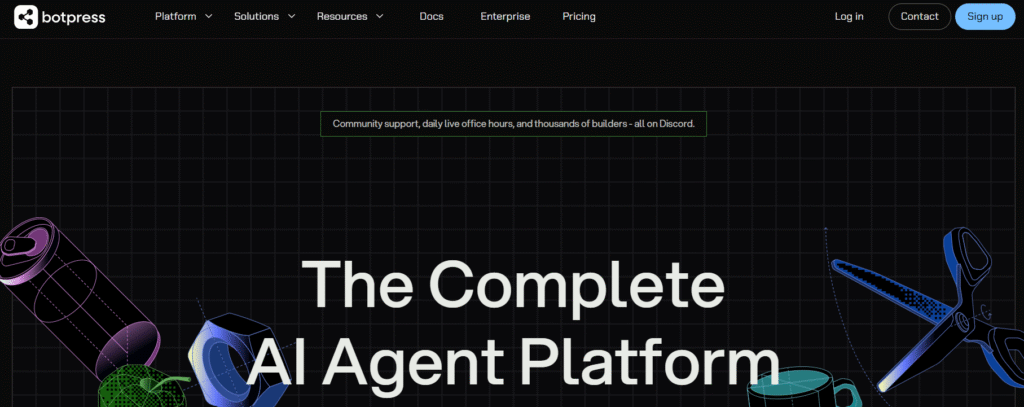
Botpress is an open-source chatbot framework that offers flexibility and customization options. It allows institutions to build and deploy chatbot solutions tailored to their specific needs.
Key Feature: Being an open-source platform makes Botpress highly adaptable to the institution’s unique needs.
Pro: Extensive customization and integration possibilities, making it a flexible solution for institutions with specific technical requirements.
Con: Support and maintenance may rely on the institution’s technical team or external developers.
The Bottom Line
Chatbots for education aren’t just trend-following technology—they’re strategic tools that save time, improve student satisfaction, and boost enrolment rates. When integrated with robust CRM systems, like the LeadSquared higher education CRM, these educational chatbots can help scale personalized communication while gaining valuable insights into student behavior.
Whether you’re looking to implement a WhatsApp chatbot for education or a comprehensive conversational AI in education solution, the technology is ready to transform your institution’s student experience.
FAQs on chatbot for education
What are the main responsibilities of an AI assistant during learning and assessment?
AI assistants are making it easier than ever for students to get timely help and guidance—whenever and wherever they need it. But what exactly do these digital learning companions do as part of the learning and assessment journey?
Here’s how an AI assistant can support students and instructors alike:
Instant answers to student questions: Whether it’s clarifying assignment deadlines, explaining confusing concepts, or answering quick course-related FAQs, AI assistants provide on-demand support so students aren’t left waiting for a response.
Competency-based practice: These assistants help students practice their newly acquired skills, often adapting exercises based on individual performance—giving each learner just the right level of challenge to promote mastery.
Personalized tutoring: By tracking individual progress and preferences, AI assistants can tailor explanations, suggest resources, and adjust their approach to suit each student’s unique learning style.
Continuous feedback and social learning: They don’t just deliver answers—they also pose questions to students to check understanding, gather feedback, and encourage reflection. This ongoing dialogue not only helps students track their own progress but also equips instructors with valuable insights to guide and adjust teaching methods.
AI assistants are designed to nurture ongoing engagement, ensure no question goes unanswered, and bring a new level of personalization to every student’s learning experience.
How can we quickly build powerful education chatbots without coding?
You don’t necessarily need a computer science degree—or even a tech team—to launch a robust education chatbot. Thanks to modern platforms like LeadSquared, with intuitive, drag-and-drop interfaces, building and customizing a solution is quicker than ever.
Speedy deployment: Pre-designed templates and guided setup mean you can go from idea to live chatbot in just hours, not weeks.
No coding required: Everything is click-and-configure, making it accessible to non-technical staff across departments.
Zero IT bottlenecks: No need to call in your IT team or submit endless support tickets. You’re in control from start to finish.
With these platforms, virtually anyone in your institution can set up a chatbot tailored to educational needs—whether it’s for student services, admissions, or library support—faster than you can say, “Can I help you?”
Is it possible to build and test education chatbots for free before launching?
If you’re wondering whether you can test out an education chatbot before making any commitments, you’re in luck. Many leading platforms allow institutions to design, build, and experiment with chatbot workflows at no cost prior to launching. You’ll have the chance to preview exactly how your chatbot will manage common queries, all without needing to pay upfront or rush your process.
How can AI assistants engage and support alumni in continued learning?
AI-powered chatbots aren’t just for current students—alumni teams can also harness their potential to deepen connections and foster ongoing engagement after graduation.
Chatbots can keep alumni networks active by initiating personalized, two-way conversations. For example, they can reach out to graduates to learn how their education has impacted their careers or invite them to share their latest achievements. This feedback loop not only keeps the alumni informed but also helps institutions tailor further offerings.
Additionally, these digital assistants can serve as a resource hub by answering frequently asked questions about alumni events, professional development opportunities, or campus updates. Whether it’s clarifying the benefits of joining a LinkedIn alumni group or detailing upcoming virtual workshops, a chatbot streamlines communication and supports career growth.
How can an AI chatbot help improve student engagement?
AI chatbots can answer student queries instantly, guide them through admissions processes, and provide personalized learning support. This ensures students remain engaged without long wait times for responses.
Can an AI chatbot help educators and administrators?
Yes. LeadSquared’s AI chatbot reduces repetitive queries by automating FAQs, scheduling, and follow-ups. This frees up time for educators and administrators to focus on teaching and student success.





